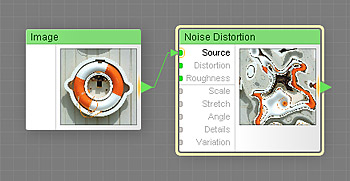
The Noise Distortion component produces a natural-looking distortion effect based on two Perlin noise functions (one for each coordinate). A similar effect can be achieved by using an Offset component with its Offset X and Offset Y supplied by two Perlin Noise components with different Variation values. Noise Distortion is a map component, it can be located in the Processing category on the Components Bar. This component can output HDR colors.
Source: Map Input (HDR), Required
Provides the source image to be distorted. This is a required input – in order to make Noise Distortion work, this input must be connected. This input can accept HDR colors.
Distortion: Map Input
Adjusts the distortion amount. The value of 0 has no effect, and the value of 100 results in the maximum distortion. Since Distortion is a map input, its value can be controlled separately for different image areas by connecting a map component to this input.
Roughness: Map Input
Defines the roughness of the noise the distortion is based upon. Technically, Roughness defines the relative transparency of the octaves the noise is composed of (the number of octaves is controlled by the Details parameter). Roughness of 0 sets all octaves but the first to zero transparency, which is equivalent to setting the Details parameter to 0. Low roughness, approximately 0 to 30, results in smoother noise because large-grained octaves have the greatest visibility. Higher roughness values increase the visibility of smaller-grained octaves, making the noise rougher. Roughness has no effect when Details is set to 0, because in this case only one octave is visible. Since Roughness is a map input, its value can be controlled separately for different image areas by connecting a map component to this input.
Lower Roughness can speed up the rendering – when the visibility of smaller-grained octaves is very close to zero, they are 'turned off' to save the rendering time. Also, avoid using Roughness values of 50 and higher for height maps, because this can lead to clamping artifacts which appear as flat regions on the height map.
Adjusts the scale of the noise the distortion is based upon. The resulting scale is also affected by the global parameter Size.
Defines how directional the noise is upon which the distortion is based. Stretch of 100 produces a fully directional noise, while Stretch of 0 eliminates the directional preference.
Defines the rotation angle of the noise texture the distortion is based upon. The effect of the Angle parameter is the most visible on non-zero Stretch values. The noise is rotated around the upper-left corner.
Adjusts the complexity of the noise the distortion is based upon. Technically, Details sets the number of octaves the noise is composed of. Details of 0 means one octave, 20 means 3 octaves and 100 means 11 octaves. Values such as 27 mean that first three octaves have full visibility, and the fourth one has 70% visibility. Details has no effect when Roughness is set to 0, because in this case only the first octave has 100% visibility no matter how many octaves are active.
Large Details value leads to longer rendering times because it increases the number of octaves to calculate. For example, when Details is 0, only one octave is rendered. When Details is 100, eleven octaves are rendered which can slow down the rendering up to eleven times. So if you don't need a high number of octaves, you can lower it to make the filter quicker.
Variation, technically known as random seed, affects the random aspects of the component which cannot be controlled directly: it randomizes the location of the noise feature points (or 'lumps') and their maximum lightness. The randomization is also affected by the global Variation value. For more information, see How Variation Works.